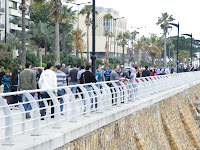Lebanon Final Days
On Day 4 of our tour we opted out of driving through to the Valley of the Saints and the Cedars to take our guide’s invitation to spend the day exploring the area of the skifields of Faraya and Faqra where the remains of a Greek temple, tombs and columns dedicated to Adonis and later Roman ruins stood deep in the snow drifts.

The views were spectacular as we drove through 15 metre snowdrifts, sheer cliffs and bluffs with waterfalls and a natural 38 metre arched stone bridge spanning between two rocky bluffs.


The ski fields were doing brisk business with several thousand people riding the six chair lifts up to the different fields around the township. We rode a lift up to the 2450 metre summit for views over the valleys then headed back down the mountain to sit, snow burnt and relaxed to watch the passing parade of skiers and tourists and drink coffee at the Austria cafe and ski shop.


Walid then drove us into town where we visited his parents in their home nestled amid huddle of houses amid the maples and remains of snow drifts of Faraya. We were treated to home made cider, coffee, home-baked biscuits and orchard stored apples as we chatted, through Walid, about families and their different lives before heading down through Faqra to Jouneih.
 |
| With Walid's family |
The next day we headed back to Beirut for three days of self directed tourism - museum visiting, checking out the shops of the rebuilt “Beirut Souq” which is a high end shopping complex created in the central town from the ruins left from the Civil War. We discovered that on a Sunday the locals spend the day strolling the Corniche or dallying over a long lunch at the numerous restaurants that line the St George Marina. With the soft warmth of the Mediterranean washing over us and the sheen of the snow covered Lebanon mountains in the distance made this choice of life style very, very attractive!
The museum and the area around it bears testament to the ravages of the Civil War which had had its 15km long front line running down the Green Line - now the main road to Damascus. The area is dotted with buildings with their frontages bullet chipped and shell stripped some of which are, apparently, being retained as a reminder of the horrors and futility of war.



The museum has some of the best artifacts from the different civilisations that have passed through Lebanon over the millennia. The displays of sarcophagii, votive offerings and jewelry demonstrated the ways people had adapted and intertwined their beliefs and arts to make their own idiosyncratic culture. The most striking were two sacrophogii made of marble modelled on Egyptian ones but with the faces carved in realistic Hellenic style.



We tried to make sense of the Civil War but gave up after wading through several pages of Wikipedia describing the machinations of the different sides along with the activities of the Palestinian Liberation Organisation and the Israelis as they manipulated the factions to suit their different agendas. Instead we marvelled at the way the Lebanese have worked to heal the rifts and damage of the war and rebuild Beirut.
We left Lebanon promising ourselves that we would return as our all too brief a visit had offered us the promise of other places to see and explore.








1 comment:
How fascinating, I wish I could have come. Maybe next time, with little Georgie in tow.
Post a Comment